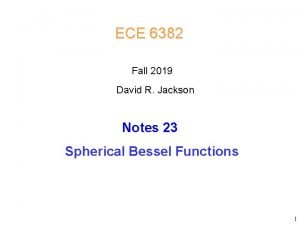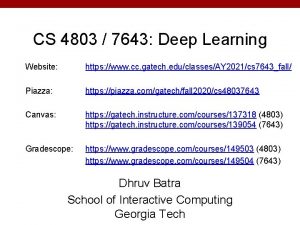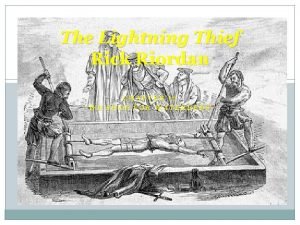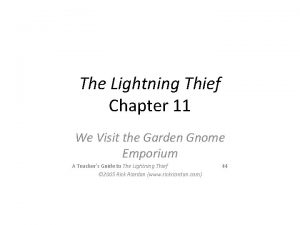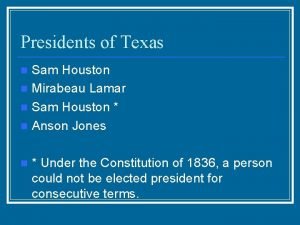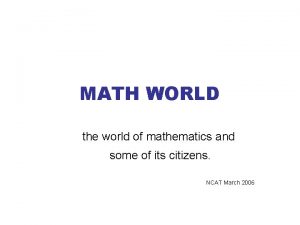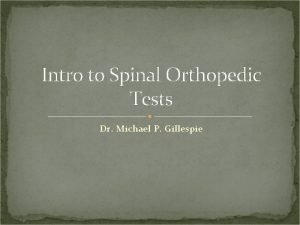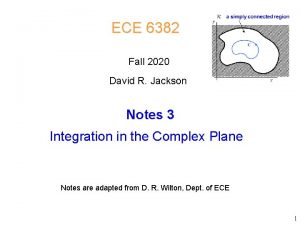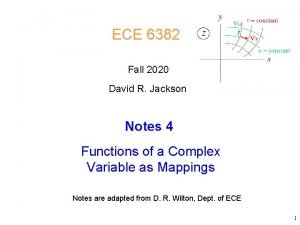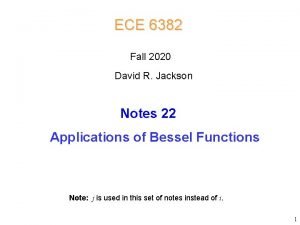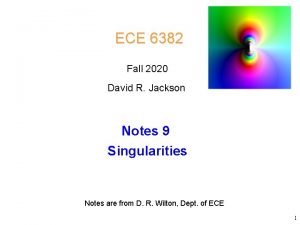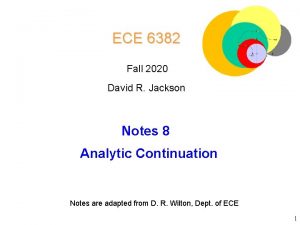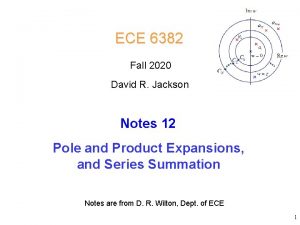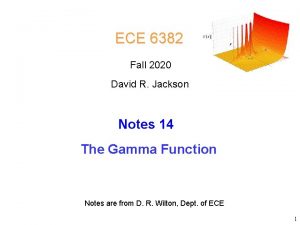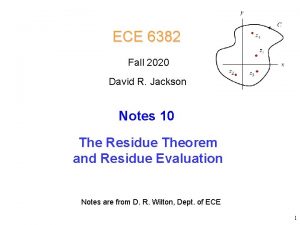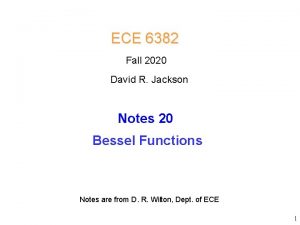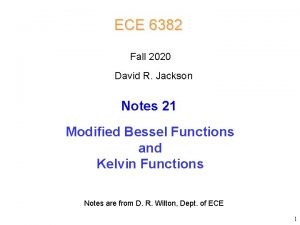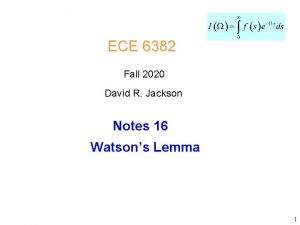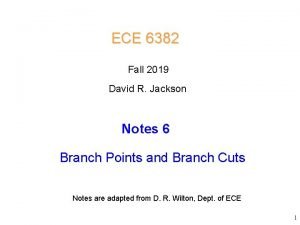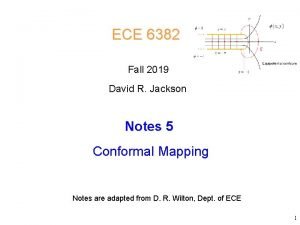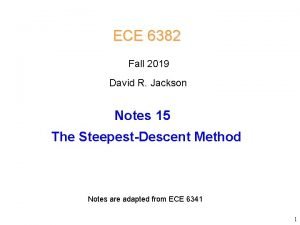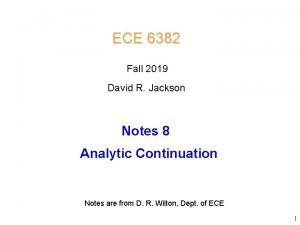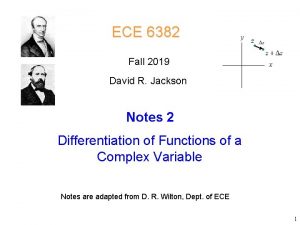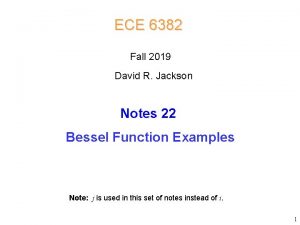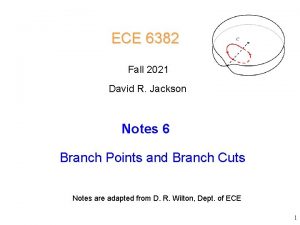ECE 6382 Fall 2020 David R Jackson Notes























































- Slides: 55

ECE 6382 Fall 2020 David R. Jackson Notes 15 The Steepest-Descent Method Notes are adapted from ECE 6341 1

Steepest-Descent Method Complex Integral: The method was published by Peter Debye in 1909. Debye noted in his work that the method was developed in a unpublished note by Bernhard Riemann (1863). Peter Joseph William Debye (March 24, 1884 – November 2, 1966) was a Dutch physicist and physical chemist, and Nobel laureate in Chemistry. Georg Friedrich Bernhard Riemann (September 17, 1826 – July 20, 1866) was an influential German mathematician who made lasting contributions to analysis and differential geometry, some of them enabling the later development of general relativity. http: //en. wikipedia. org/wiki/Peter_Debye http: //en. wikipedia. org/wiki/Bernhard_Riemann 2

Steepest-Descent Method (cont. ) Complex Integral: We want to obtain an approximate evaluation of the integral when the real parameter Ω is very large. The functions f (z) and g(z) are analytic (except for poles or branch points), so that the path C may be deformed if necessary (possibly adding residue contributions or branch-cut integrals). Saddle Point (SP): (This is the point that ends up contributing the most. ) 3

Steepest-Descent Method (cont. ) Path deformation: If the path does not go through a saddle point, we assume that it can be deformed to do so. If any singularities are encountered during the path deformation, they must be accounted for (e. g. , residue of captured poles). X 4

Steepest-Descent Method (cont. ) Denote Cauchy Reimann eqs. : Hence Switch order 5

Steepest-Descent Method (cont. ) or If then Near the saddle point: (We can rotate coordinates to eliminate) 6

Steepest-Descent Method (cont. ) In the rotated coordinate system: Assume that the coordinate system is rotated so that Note: The angle of rotation necessary to do this will be clear later (it is the departure angle SDP of the steepest-descent path). 7

Steepest-Descent Method (cont. ) The u (x , y ) function has a “saddle” shape near the SP: 8

Steepest-Descent Method (cont. ) This is what the saddle looks like in the original coordinate system. Note: The saddle does not necessarily open along one of the principal axes (only when uxy (x 0, y 0) = 0). 9

Steepest-Descent Method (cont. ) A descending path is one on which the u function decreases away from the saddle point. 3 D view of a descending path 10

Steepest-Descent Method (cont. ) Along any descending path C we will have convergence: Exponentially decreasing function 11

Steepest-Descent Method (cont. ) Behavior on a Descending Path Note: The parameter s is related to the distance along the path from the saddle point. The convention is that negative s means before we get to the saddle point, positive s means after we leave the saddle point. When is large, most of contribution is from near z 0. 12

Steepest-Descent Method (cont. ) Sketches of a descending path: 13

Steepest-Descent Method (cont. ) Along any descending path: Both the phase and amplitude change along an arbitrary descending path C. Important Point: If we can find a path along which the phase does not change (v is constant), the integrand will have a purely exponentially decaying behavior (no phase term), making the integral easy to evaluate. 14

Steepest-Descent Method (cont. ) Choose a path C 0 of constant phase: 15

Steepest-Descent Method (cont. ) Gradient Property (proof on next slide): Hence C 0 is either a “path of steepest descent” (SDP) or a “path of steepest ascent” (SAP). SDP: u(x, y) decreases as fast as possible along the path away from the saddle point. SAP: u(x, y) increases as fast as possible along the path away from the saddle point. 16

Steepest-Descent Method (cont. ) Proof C. R. Equations y Hence, Also, C 0 x Hence 17

Steepest-Descent Method (cont. ) Because the v function is constant along the SDP, we have: or Real 18

Steepest-Descent Method (cont. ) Local behavior near SP so Denote 19

Steepest-Descent Method (cont. ) SAP: SDP: Note: The two paths are 90 o apart at the saddle point. 20

Steepest-Descent Method (cont. ) y u increases SDP SP 90 o u decreases SAP x Note: v(x, y) is constant along both paths. 21

Steepest-Descent Method (cont. ) The “landscape” of the function u(z) near z 0 Hill Valley Hill 22

Steepest-Descent Method (cont. ) SAP SDP 23

Steepest-Descent Method (cont. ) Set This defines SDP 24

Steepest-Descent Method (cont. ) We then have or (leading term of the asymptotic expansion) Hence 25

Steepest-Descent Method (cont. ) To evaluate the derivative: (Recall: v is constant along SDP. ) At the SP this gives 0 = 0. Take one more derivative: 26

Steepest-Descent Method (cont. ) At so Hence, we have 27

Steepest-Descent Method (cont. ) There is an ambiguity in sign for the square root: To avoid this ambiguity, define 28

Steepest-Descent Method (cont. ) The derivative term is therefore Hence 29

Steepest-Descent Method (cont. ) To find SDP : Denote 30

Steepest-Descent Method (cont. ) SDP SAP The two sign choices correspond to going one way (e. g. , “up”) or the other way (e. g. , “down”) on the SDP. The direction of integration determines The sign. The “user” must determine this. 31

Steepest-Descent Method (cont. ) Summary 32

Example where Hence, we identify: 33

Example (cont. ) y x 34

Example (cont. ) Identify the SDP and SAP: 35

Example (cont. ) SDP and SAP: SAP Examination of the u function reveals which of the two paths is the SDP 36

Example (cont. ) Vertical paths are added so that the path now has limits at infinity. SDP = C + Cv 1 + Cv 2 It is now clear which choice is correct for the departure angle: SDP 37

Example (cont. ) (If we ignore the contributions of the vertical paths. ) Hence, so 38

Example (cont. ) Hence 39

Example (cont. ) Examine the path Cv 1 (the path Cv 2 is similar). Let 40

Example (cont. ) since Since is becoming very large, we can write: Hence, we have 41

Example (cont. ) Hence, Iv 1 is a much smaller term than what we obtain from the method of steepest descent, when gets large, and we can ignore it. 42

Example The Gamma (generalized factorial) function: Note: There is no saddle point! Let 43

Example (cont. ) or 44

Example (cont. ) Recall the recipe: Note: The SDP is the positive real axis (see the derivation below). The departure angle is zero, not , since we are integrating from 0 to . Hence or This is Sterling’s formula (leading term). 45

Complete Asymptotic Expansion We can obtain the complete asymptotic expansion of the integral with the steepest-descent method (including as many higher-order terms as we wish). The path is along the SDP. Change of variables: Define: Then we have 46

Complete Asymptotic Expansion (cont. ) (Extending the limits to infinity gives an exponentially small error: This does not affect the asymptotic expansion. ) Assume Note: We can use an equal sign if h is analytic at s = 0, which is usually the case. Then Note: The integral is zero for n = odd (the integrand is then an odd function). This result is called “Watson’s Lemma”: We can obtain the complete asymptotic expansion of I by substituting in the complete asymptotic expansion for h and integrating term-by-term. 47

Complete Asymptotic Expansion (cont. ) Performing the integration, where We then have 48

Complete Asymptotic Expansion (cont. ) Summary where 49

Complete Asymptotic Expansion (cont. ) Note: Keeping only the leading term gives the usual steepest-descent result. where 50

Complete Asymptotic Expansion (cont. ) Example: We have SDP: y = 0 (real axis) SAP: x = 0 (imaginary axis) 51

Complete Asymptotic Expansion (cont. ) Also, we have y Hence x We then have 52

Complete Asymptotic Expansion (cont. ) Hence Recall: 53

Complete Asymptotic Expansion (cont. ) The complete asymptotic expansion is Hence we have: so that where (Please see the notes on the Gamma function. ) 54

Complete Asymptotic Expansion (cont. ) Hence we have: as Note: In a similar manner, we could obtain higher-order terms in the asymptotic expansion of the Bessel function or the Gamma function. 55
 Andrew jackson doodle
Andrew jackson doodle David r jackson
David r jackson David r jackson
David r jackson Cs 7643 fall 2020
Cs 7643 fall 2020 Task level parallelism
Task level parallelism Cs61c fall 2020
Cs61c fall 2020 Cube wisc
Cube wisc Michael r. jackson
Michael r. jackson Who is in this picture
Who is in this picture Tony blair mbti
Tony blair mbti Us prior to brown map key
Us prior to brown map key The lottery shirley jackson questions
The lottery shirley jackson questions Walter jackson freeman ii
Walter jackson freeman ii General jackson slaying the many headed monster
General jackson slaying the many headed monster Michael jackson psychodynamic
Michael jackson psychodynamic Andrew jackson trail of tears map
Andrew jackson trail of tears map The possibility of evil questions
The possibility of evil questions Discussion questions for the lottery
Discussion questions for the lottery Percy jackson ch 17
Percy jackson ch 17 What is percy's fatal mistake while battling the chimera
What is percy's fatal mistake while battling the chimera Lightning thief lesson plans
Lightning thief lesson plans Chapter 11 the lightning thief
Chapter 11 the lightning thief Percy jackson and the olympians chapter 6
Percy jackson and the olympians chapter 6 Chapter 2 of percy jackson and the lightning thief
Chapter 2 of percy jackson and the lightning thief Jackson rees intersurgical
Jackson rees intersurgical Peeples middle school
Peeples middle school Structured analysis and structured design (sa/sd)
Structured analysis and structured design (sa/sd) Seven types of ambiguity shirley jackson
Seven types of ambiguity shirley jackson Loulou lemmon
Loulou lemmon Protesis parcial removible clase 3 modificacion 1
Protesis parcial removible clase 3 modificacion 1 Mirabeau lamar campaign poster
Mirabeau lamar campaign poster Percy jackson zloděj blesku postavy
Percy jackson zloděj blesku postavy I battle my jerk relative
I battle my jerk relative Come si chiama
Come si chiama Percy jackson personages
Percy jackson personages Bohaterowie percy jackson
Bohaterowie percy jackson Percy jackson and the lightning thief dionysus
Percy jackson and the lightning thief dionysus Percy jackson vocabulary chapters 5-8
Percy jackson vocabulary chapters 5-8 Spoils system
Spoils system Maynard jackson drawing
Maynard jackson drawing Trachette jackson
Trachette jackson Jackson gulch reservoir
Jackson gulch reservoir Percy jackson lubimyczytac
Percy jackson lubimyczytac Joseph jackson lister
Joseph jackson lister Jackson pollock no 5
Jackson pollock no 5 Jacksons compression test
Jacksons compression test Todd jackson hockey canada
Todd jackson hockey canada Jackson high school hours
Jackson high school hours Frederick jackson taylor
Frederick jackson taylor Nomogram for percent body fat
Nomogram for percent body fat Michael jackson rock my world lyrics
Michael jackson rock my world lyrics Joseph schwab modelo curricular
Joseph schwab modelo curricular Michael jackson pharmacist
Michael jackson pharmacist The lottery by shirley jackson vocabulary
The lottery by shirley jackson vocabulary Charles by shirley jackson literary elements
Charles by shirley jackson literary elements Jackson's theory of thermal burns
Jackson's theory of thermal burns


